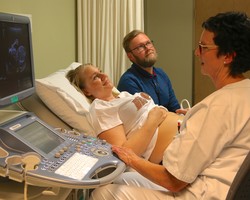Eva Tegnander – educating midwives on ultrasound technology for more than 30 years

Sturla H. Eik-Nes
Eva Tegnander has been a midwife in Norway for 38 years. She started her career working in delivery wards. In 1985, when an ultrasound laboratory was set up at St Olavs University Hospital in Trondheim, she was one of the first 2 midwives at that hospital trained in using the technology. She then became part of a small team that built up the National Centre for Fetal Medicine (NCFM), and she has been training midwives and gynaecologists in ultrasound scanning for more than 30 years.
“Ultrasound technology had already been introduced in Norway in the mid-1970s, but then there were only a few machines in the country and the examiners were lacking ultrasound skills,” Eva explains. “As a result, some pregnant women were scanned very frequently, most were not scanned at all, and the ultrasound results had no impact.”
She continues, “In 1986, Norway became one of the first countries where the government officially offered ultrasound scanning to all pregnant women. This 18-week examination ensured that the scan was performed when both the health of the fetus and the due date could be assessed accurately. It was also stated that a trained gynaecologist or midwife should do the scan, although at that time ultrasound scans in most countries were performed by sonographers or doctors, not midwives. I was very interested in the possibilities offered by ultrasound for the care of the mother and the fetus, and also knew that it had to be done properly to make a difference. This is how I started working with ultrasound education”.
Empowering midwives to perform ultrasound examinations
“In the late 1980s, the Norwegian health authorities encouraged the inclusion of more midwives in general pregnancy care, a shift that was welcomed by pregnant women. I understood that ultrasound ought to be a natural extension of midwives’ work. I was asked to develop a training for midwives in ultrasound and visited universities in the United States and the United Kingdom to get an understanding of the training for sonographers. In 1990, I developed the first ultrasound curriculum for Norwegian midwives. A few years later, the first ultrasound training was established at the Norwegian University of Science and Technology (NTNU) as a 1-year university-based postgraduate education. It is currently the only one of its kind, but the interest in midwives’ use of ultrasound is growing in the Nordic countries.
Today, midwives and gynaecologists from all over Norway benefit from the training we provide. The training is evidence-based, and much of that research comes from the NCFM. We have an active research group at the NCFM and we also cooperate with the researches at NTNU who are developing ultrasound technology. Research is very important for us. The main topic of my PhD research, for example, was examining the fetal heart to improve prenatal diagnosis.
At the present, most ultrasound examinations during pregnancy are performed by approximately 200 ultrasound educated midwives. Having an established training curriculum ensures that pregnant women across Norway have access to high-quality scans, regardless of where they live.
I love the work that I do as an ultrasound midwife. I was fortunate to be at the right place at the right time in 1985, and offered to contribute to the use of ultrasound by midwives. I see it as important for the parents, for mothers and for the fetus. I like the setting and I enjoy connecting with the parents as they see their baby for the first time. I also like teaching, to enable other midwives to do quality work.”
The impact on health
The first reported evidence-based result of the introduction of ultrasound in pregnancy care in Norway was a reduction in the induction of post-date pregnancies. This was due to the improved assessment of gestational age using ultrasound, compared to traditional dating using the menstrual period. The precise dating also improved the ability to detect any issues related to fetal growth. The findings of an 18-week fetal assessment can lead to better pregnancy care, focused on the specific fetal condition.
Delivering ultrasound education internationally
In its role as a WHO teaching and training centre for ultrasound in obstetrics and gynaecology, the NCFM started providing trainings in low- and middle-income countries in 1997, with Eva playing a key role. Together with colleagues from the NCFM, Eva was invited to the province of KwaZulu-Natal in South Africa to explore and support midwives’ use of ultrasound in rural areas. There is reason to believe that the introduction of ultrasound in pregnancy will significantly reduce the perinatal mortality rate in that country. South African midwives are now looking into the possibility of establishing an official ultrasound education for midwives.
Thanks to her work in empowering midwives, both nationally and internationally, Eva became an Honorary Member of the Midwife Federation of the Norwegian Nurses Organisation and an Honorary Associate Professor at the Nelson R. Mandela School of Medicine, University of KwaZulu-Natal, South Africa. She is also an Associate Professor at NTNU in Trondheim, and she co-edited the textbook on Norwegian midwifery that is used by all midwifery students today.



